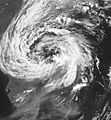Subtropical Storm Andrea (2007) facts for kids
| Subtropical storm (SSHWS/NWS) | |

Subtropical Storm Andrea shortly before being named.
|
|
| Formed | May 9, 2007 |
|---|---|
| Dissipated | May 11, 2007 |
| Highest winds | 1-minute sustained: 60 mph (95 km/h) |
| Lowest pressure | 1001 mbar (hPa); 29.56 inHg |
| Fatalities | 6 direct (mostly while extratropical) |
| Damage | Minimal |
| Areas affected | North Carolina, South Carolina, Georgia, Florida |
| Part of the 2007 Atlantic hurricane season | |
Subtropical Storm Andrea was the very first named storm of the 2007 Atlantic hurricane season. It was also the first subtropical cyclone of that year. Andrea formed on May 9, 2007. This was about three weeks before the official start of the hurricane season.
The storm began as a rainy weather area near Daytona Beach, Florida. Andrea stayed in roughly the same spot for a while. On May 10, it became weaker and turned into a subtropical depression. This happened because it moved into an area with dry air and strong winds that pulled it apart. The next day, the National Hurricane Center stopped tracking Andrea.
Andrea caused big waves along the coasts from Florida all the way to North Carolina. Six people were affected by the storm, mostly before it even became a subtropical storm. Andrea caused only a little bit of damage.
This storm was the first tropical storm to form before the official season start since Tropical Storm Ana in 2003. It was also the first named storm to form in May since Tropical Storm Arlene in 1981.
Contents
How Subtropical Storm Andrea Formed
Subtropical Storm Andrea started from a large area of rain and clouds. This weather system slowly moved over the Atlantic Ocean near the coast of South Carolina. As it got stronger, the National Hurricane Center started watching it closely.
On May 9, the system was officially named "Andrea." This happened after experts saw that it had a spinning center and looked like a subtropical storm. A subtropical storm is a mix between a tropical storm and a regular storm.
Andrea didn't move much after it formed. Soon, it started to get weaker. It turned into a subtropical depression. This was because it ran into dry air and strong wind shear. These conditions make it hard for storms to stay strong. Andrea finally faded away near the coast of Florida on May 11. It simply fell apart due to the bad weather conditions around it.
Getting Ready for Andrea
Even before Andrea became a subtropical storm, it caused high waves. Because of these waves, the National Weather Service told people to be careful along the coasts of Florida and North Carolina.
Right after Andrea was named, the National Hurricane Center gave out Tropical Storm Watches. These warnings were for the coasts of Florida and Georgia. However, the NHC stopped these warnings once Andrea became weaker. A warning for strong winds was also given for much of the South Carolina coastline.
Andrea's Impact
Subtropical Storm Andrea affected six people. Most of these impacts happened before Andrea was even named a subtropical storm. The storm caused only minor damage along the coasts of Florida and North Carolina.
Related Pages
|
Tropical cyclones of the 2007 Atlantic hurricane season |
|||||||||||||||||||||||||||||||||
|
|
||||||||||||||||||||||||||||||||
|
|
|||||||||||||||||||||||||||||||||
Images for kids
See also
 In Spanish: Tormenta subtropical Andrea (2007) para niños
In Spanish: Tormenta subtropical Andrea (2007) para niños




